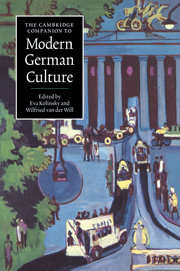Book contents
- Frontmatter
- In search of German culture: an introduction
- 1 The citizen and the state in modern Germany
- 2 German national identity
- 3 Elites and class structure
- 4 Jews in German society
- 5 Non-German minorities, women and the emergence of civil society
- 6 Critiques of culture
- 7 The functions of 'Volkskultur', mass culture and alternative culture
- 8 The development of German prose fiction
- 9 Modern German poetry
- 10 German drama, theatre and dance
- 11 Music in modern German culture
- 12 Modern German art
- 13 Modern German architecture
- 14 German cinema
- 15 The media of mass communication: the press, radio and television
- Index
15 - The media of mass communication: the press, radio and television
Published online by Cambridge University Press: 28 May 2006
- Frontmatter
- In search of German culture: an introduction
- 1 The citizen and the state in modern Germany
- 2 German national identity
- 3 Elites and class structure
- 4 Jews in German society
- 5 Non-German minorities, women and the emergence of civil society
- 6 Critiques of culture
- 7 The functions of 'Volkskultur', mass culture and alternative culture
- 8 The development of German prose fiction
- 9 Modern German poetry
- 10 German drama, theatre and dance
- 11 Music in modern German culture
- 12 Modern German art
- 13 Modern German architecture
- 14 German cinema
- 15 The media of mass communication: the press, radio and television
- Index
Summary
In a modern-day society, the means by which its members communicate with each other are a constitutive element of its make-up. The central place of communication and mass communication applies to the world of work but has also become an integral part of leisure activities. In contemporary Germany, leisure and the media of mass communication have become inseparable facets of everyday culture: 'according to recent leisure research... reading books... occupies only the tenth place of the most frequent leisure activities, after watching television (80 per cent), reading newspapers or magazines (62 per cent), listening to the radio (59 per cent), talking on the telephone (44 per cent), having a cup of coffee or a glass of beer (42 per cent), socialising with friends (37 per cent), gardening (36 per cent), sleeping late (36 per cent) and listening to records or audio cassettes (33 per cent)' Thus, much of the leisure time of Germans is taken up by interacting with and through media. Media of mass communication such as newspapers, the telephone, television and radio rank highly in contemporary society and culture.
- Type
- Chapter
- Information
- The Cambridge Companion to Modern German Culture , pp. 322 - 337Publisher: Cambridge University PressPrint publication year: 1999



